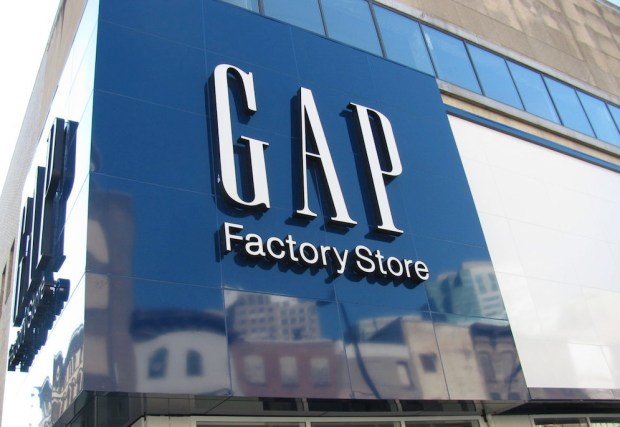Gap’s Turnaround Troubles

There comes a point when a rough patch is no longer a rough patch and needs to be designated something else. “Patch” implies something transitory: a brief spot of disturbance. If a business or individual has been bouncing about in the turbulence for a year or more, patch is not doing enough rhetorical heavy lifting. Words like “funk” or “phase” spring to mind.
Gap Inc., as its most recent financial disclosures indicate, is trending toward a funk. The most recent run of numbers is another collection of downward pointing arrows. Sales are at best flat and at worst down by 9 percent, depending on which of Gap Inc.’s stores one is looking at. Revenue is down, profit is nearly half what it was a year ago and stores are closing.
Gap’s struggles are not exactly unique. It’s one of many brands struggling to define and place itself in the mobile and digital era — and consistently finding itself not quite getting there. Macy’s has found itself in the same boat of late, as have Target and J. Crew. But Gap Inc., in the person of CEO Arthur Peck, has been calling for its imminent turnaround loudly and proudly all year.
“With a year of transition behind us, I’m confident that we have the right strategies in place to fuel our long-term growth,” Peck said during February’s earnings call with investors. “We made significant progress in 2015, transforming our product operating model, enabling us to be more responsive to trends and market conditions and consistently deliver on-brand product collections. Our brands are strengthening their connections with customers through digital, and especially mobile, enhancements that create richer experiences, whether shopping online or in stores or any combination of channels.”
That chipper pronouncement in February preceded an earnings report in May described as “dismal” and “disastrous.” So much for calling one’s shots.
Now new figures are out, and though on the upside Gap managed to beat at least some of the diminished expectations the market has for it, growth is not quite visible on the horizon. And while Arthur Peck remains as optimistic as every, some are wondering if Gap Inc. is simply too out of step with consumer preferences to make a comeback feasible.
More Weak Numbers
When the quarterly numbers came out in fall they weren’t much to write home about, though they were better than the full-tilt rout on evidence in February and May. For the quarter that ended June 30 Gap reported total revenue declining 1.2 percent to $3.85 billion while profit clocked in at $125 million. That is down from a $219 million in profit Gap clocked last year at the same time. Same-store sales were a mixed picture.
The good news was that Old Navy reversed the falling foot traffic it was showing during the previous two quarters and held steady at an essentially flat rate. Gap saw comparable sales fall, but by 2 percent as opposed to the 3 percent predicted by analysts before the release. Banana Republic continue to be a drag — if anything expanding its anchor-like properties. Comparable sales were down 9 percent, a big increase from last year’s 4 percent drop.
Not amazing numbers, but at least numbers that are starting to show signs of stabilizing from the free-fall they seemed to be in earlier this year. Peck might have been off in his timing — the great turnaround most certainly did not come during spring 2016 — but he remains confident that a change in direction for Gap Inc.’s corporate fortunes remains on the horizon.
“We have a lot more work to do,” he said during a conference call with investors, noting he is unsatisfied with the pace of change in the business so far. He further noted that much of the change is actually below the surface and related to business operations, such as incorporating technical innovations into fabrics and getting the supply chain to be more nimble.
“The work is deep and it centers around core processes in the business,” Peck said.
He highlighted relative strength Gap has shown in drawing down inventory (which was running out of control earlier this year due to a warmer-than-expected winter season), strong growth in eCommerce and opportunities to build on the relative strength in the Old Navy line as possibilities that lie in front of The Gap.
But are consumers interested?
What If No One Wants To Be “Normal”?
Such is the question underlying a recent piece in Bloomberg, wondering whether The Gap and its brand-wide focus on predictable staples might be its essential problem. The “dress normal” aesthetic at The Gap might simply be out of step in a world of hipsters, lumbersexuals and a generation of Millennials raised to view themselves (and by extension their sense of style) as inherently unique and changeable.
“They were the cheap, cool option,” Bridget Weishaar, an analyst at Morningstar, said of Gap’s basic clothes. “They’ve just been displaced.”
Simeon Siegel, an analyst at Nomura Securities, concurred, noting that The Gap was trying to be the staple wardrobe provider for everyone, and ended up with a business model that is too bulky and insufficiently nimble.
“[The Gap is] simply too large in the new normal where physical distribution has become a liability and uniformity is no longer ‘cool.’”
And while the success of Zara, H&M and (to a lesser extent) Old Navy with the fast fashion trend tends to lend credence to that assessment, there is also the notable caveat that fast fashion is still a youngish trend. It remains to be seen whether it remains the shopping wave of the future. With dozens of think pieces populating the internet on the importance of slimming down one’s wardrobe, uniformizing one’s work clothes and adopting a “normcore” aesthetic, it’s easy to see how trendlines could break back toward The Gap’s take on fashion.
The question is, will The Gap still be in a position to benefit from it?
